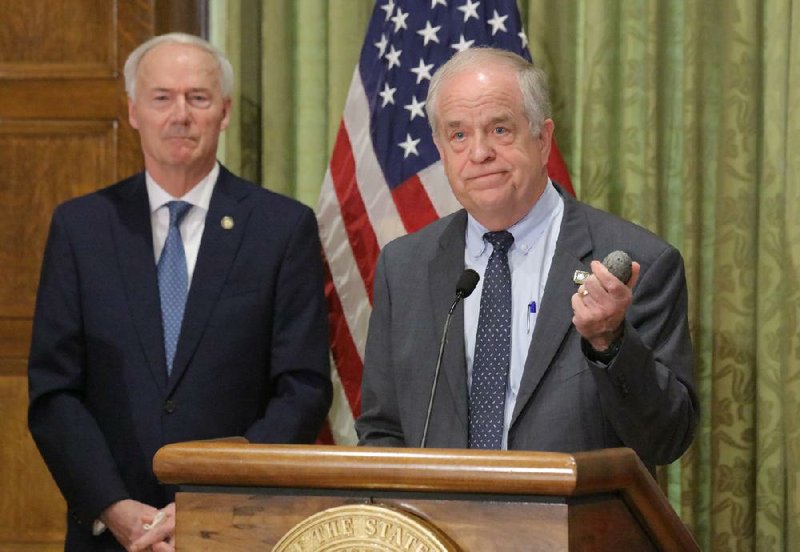A combined force of federal, state and local police agencies monitoring protesters Tuesday night in Little Rock arrested 79 people after a window was shattered at a McDonald's, Gov. Asa Hutchinson said Wednesday.
Despite the arrests, Hutchinson said that Tuesday night's protests in Little Rock were noticeably more peaceful when compared with the previous three nights, during which police used tear gas and people broke windows of businesses and started at least one fire.
The governor attributed the change to the capital city's earlier curfew -- which had been moved from 10 p.m. to 8 p.m. -- as well as a larger force of officers from nine agencies operating under the joint command of the Arkansas State Police.
"It was respectful, even though it was in violation of the curfew," Hutchinson said at a news conference to discuss how law enforcement agencies operated under an executive order he issued Tuesday afternoon.
[DOCUMENT: State of emergency executive order » arkansasonline.com/64order/]
Col. Bill Bryant, director of the Arkansas State Police, said no crowd control measures such as gas or rubber bullets were used Tuesday night.
Both the increased police presence and the decision by officers not to use more severe tactics such as tear gas likely contributed to a calmer evening, said Trisha Rhodes, a professor in the criminal-justice department at the University of Arkansas at Little Rock.
"The way that police departments respond to these protests matters," Rhodes said. "It has an impact."
For example, Rhodes said some criminologists believe that more aggressive responses by police to minor offenses -- such as breaking curfew -- can be counterproductive, provoking protesters to lash out more. Rhodes said that open communication between police agencies, their officers and the public is often the most effective way to prevent protests from escalating into violence.
Both Hutchinson and Bryant said the unified police command led by the state police decided not to intervene as the protesters marched toward the Governor's Mansion after curfew because the protesters remained peaceful. Upon their return to the state Capitol area, however, at least one person threw a stone through the window of a McDonald's on Broadway, which Bryant called the "triggering event" that prompted law enforcement authorities to move in and arrest dozens of protesters as they approached the Broadway bridge.
A later news release from the state police also ascribed "vandalism" at the Pulaski County Courthouse to the protesters.
"There's a certain element that once the nightfall hit, they're looking for an excuse both to destroy property but also to confront the police," Hutchinson said.
A list released Wednesday by the state police showed that the majority of those arrested in Little Rock on Tuesday night were in their 20s. The charge was obstructing governmental operations, a misdemeanor.
All of those arrested were from Arkansas. The youngest was 14, and the oldest was 41. Bryant said two firearms were seized.
Video captured by an Arkansas Online reporter Tuesday night also showed police detaining a group of protesters on a pedestrian bridge before letting some of the group go. The reporter was temporarily detained along with the group.
Two reporters with the Little Rock station KATV said they were also briefly detained Tuesday, despite showing their press credentials. On Monday night, a reporter with the Arkansas Democrat-Gazette was treated at a hospital and released after being struck in the face and knocked unconscious.
Hutchinson said police are there to protect protesters as well as the press, and that reporters who show their credentials should not be detained or arrested.
The agencies involved in monitoring Tuesday night's protests included the state police, FBI, the U.S. Drug Enforcement Administration, Arkansas Highway Police, Pulaski County sheriff's office, Arkansas Game and Fish Commission officers, and the police departments of Little Rock, North Little Rock and Sherwood.
The Arkansas National Guard, activated by the governor's emergency proclamation on Tuesday, were also on the ground in Little Rock on Tuesday, but did not participate in any arrests, a spokesman for the guard said.
A Section on 06/04/2020
